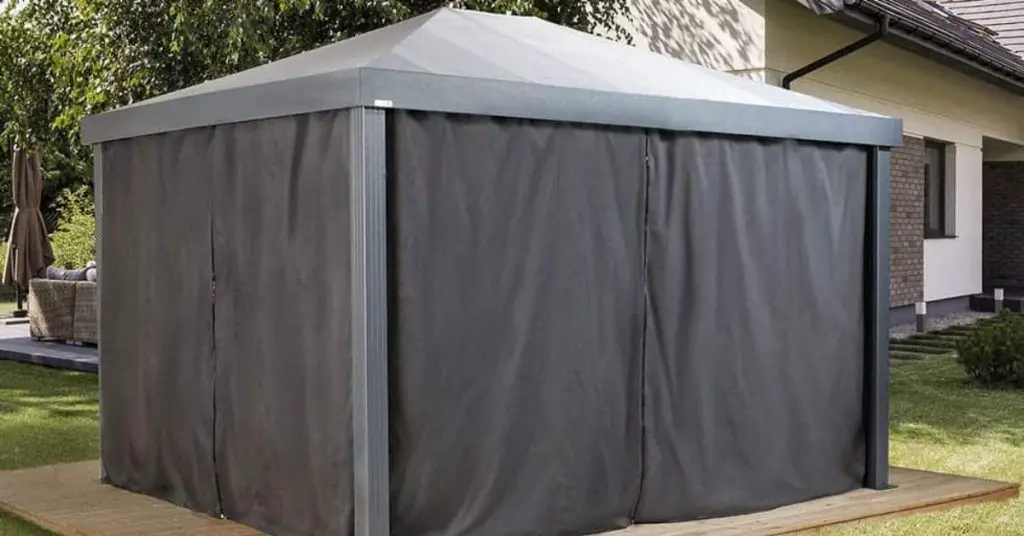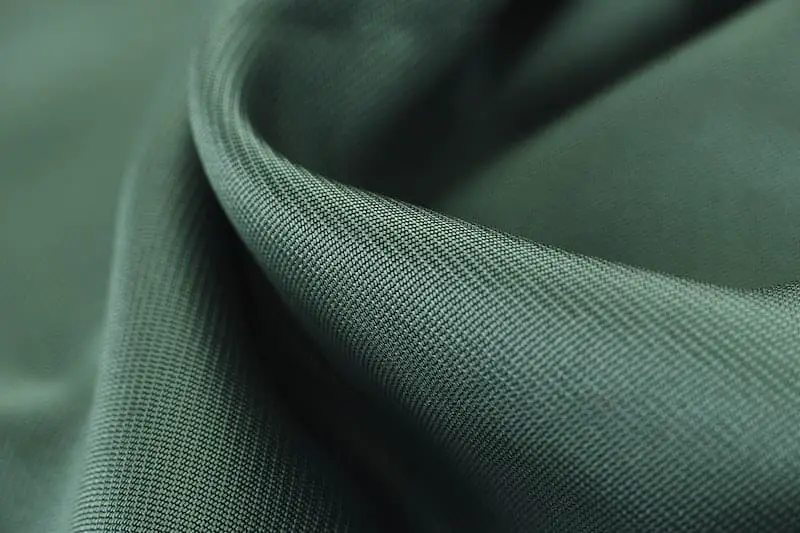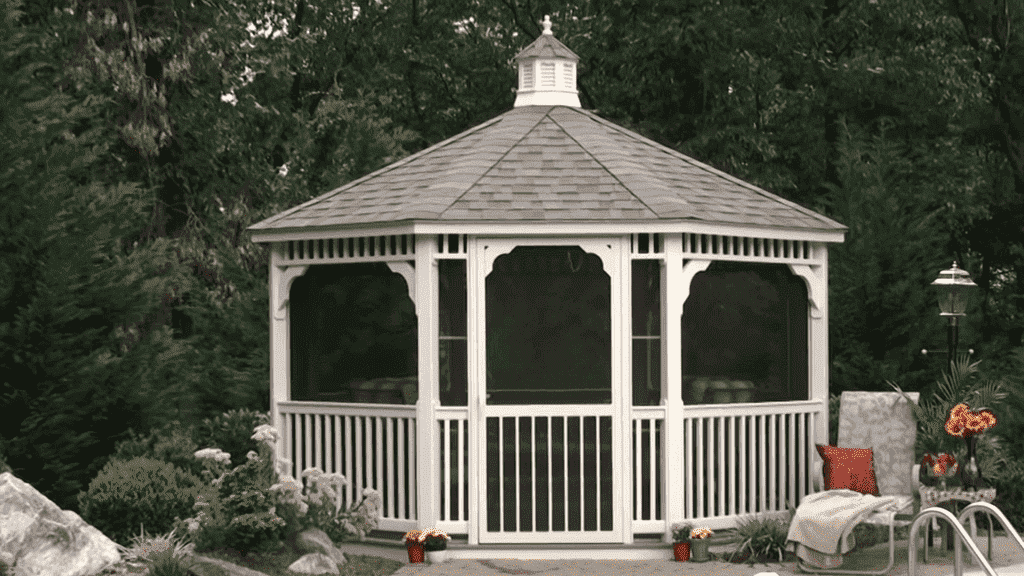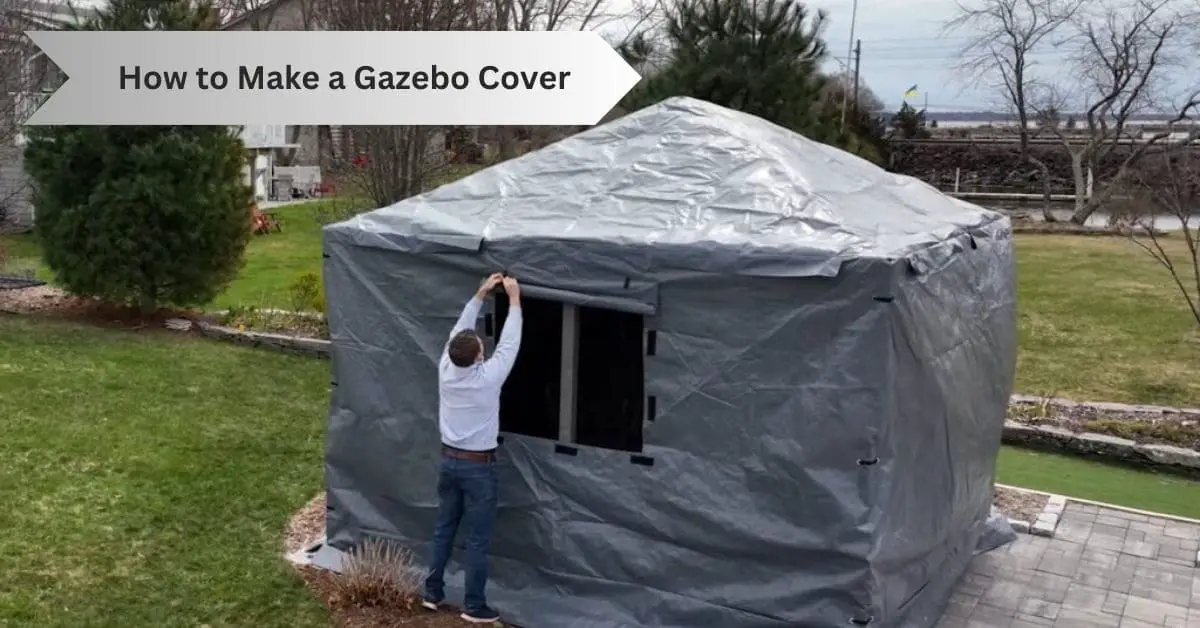A gazebo is an outdoor structure that provides a comfortable and shaded area to relax or entertain guests. However, it is essential to have a gazebo cover to protect the structure and the people under it from the sun, wind, and rain. Making your own gazebo cover can be a fun and rewarding DIY project.
This article will provide a step-by-step guide on how to make a gazebo cover, including choosing the material, measuring the gazebo, creating a pattern, cutting and sewing the fabric, installing the cover, and maintaining it for long-lasting use.
How to make a gazebo cover: protect your outdoor structure and create a comfortable shaded area. This guide covers everything from choosing the right material, measuring your gazebo, creating a pattern, cutting and sewing the fabric, to installing and maintaining the cover for long-lasting use. Enjoy your outdoor space all year round with a well-made gazebo cover.
Gazebo Cover Definition

A gazebo cover is a protective covering that is designed to fit over a gazebo frame, providing shelter from the elements. These covers are typically made from a durable fabric material that is resistant to water, wind, and UV rays.
A gazebo cover can help to keep the interior of the structure dry during rainfall, provide shade and protection from the sun’s rays on hot days, and shield occupants from the wind.
They come in various sizes and designs to fit different gazebo styles and can be purchased or made at home. A well-made gazebo cover is essential to any outdoor living space, providing both functional and aesthetic benefits.
How to make a gazebo cover-steps
Making a gazebo cover can be a great DIY project to protect yourself and your outdoor furniture from the elements. Here are the steps to make a basic gazebo cover:
- Choose the material
- Measure your gazebo
- Create a pattern
- Cut the fabric
- Sew the cover
- Install the cover
- Maintain the cover
Choosing the Right Material for Your Gazebo Cover
When making a gazebo cover, choosing the right material is essential to ensure it is durable and effective at protecting your gazebo from the elements. Here are some factors to consider when selecting a material for your gazebo cover:
Waterproof: The material should be waterproof to protect the gazebo from rainwater and prevent water damage to any furniture or decor inside.

UV-resistant: The material should be resistant to the sun’s harmful rays, as prolonged exposure can cause the material to fade and weaken over time.
Durable: The material should be strong and durable enough to withstand the elements, including wind, rain, and extreme temperatures.
Breathable: A breathable material will prevent moisture from accumulating inside the gazebo, preventing the growth of mold and mildew.
Aesthetics: The material should match the style of your outdoor living space’s style and complement your gazebo’s colors and design.
Some suitable materials for gazebo covers include canvas, polyester, vinyl, and acrylic-coated fabrics. By choosing the right material, you can ensure your gazebo cover will provide effective protection and enhance the look of your outdoor space.
Comparing Different Materials for Gazebo Covers
When it comes to choosing the perfect cover for your gazebo, there are several materials to consider. Each material has its own advantages and disadvantages, and your choice will depend on your individual needs and preferences.
This article will compare and contrast four common materials used for gazebo covers: canvas, polyester, vinyl, and Sunbrella fabric.
We will discuss the pros and cons of each material, so you can make an informed decision when selecting the ideal gazebo cover for your outdoor space.
Canvas

This traditional material is known for its durability, water resistance, and UV protection. Canvas is often used for heavier-duty applications and can be treated with waterproofing agents to increase its water resistance.
Pros:
- Durable and long-lasting
- Offers excellent water resistance and UV protection
- Can be treated with waterproofing agents for added protection
- Provides a traditional look and feel
Cons:
Can be heavier and bulkier than other materials, which can make it harder to install
May require special care and maintenance to prevent mold and mildew
More expensive than other materials
Polyester
This lightweight and easy-to-clean material is a popular choice for gazebo covers. It is also affordable and available in a range of colors and patterns.
Pros:
- Lightweight and easy to handle
- Affordable and available in a range of colors and patterns
- Quick-drying and easy to clean
- Resistant to fading and UV damage
Cons:
- May not be as durable as other materials, especially in areas with high winds or heavy rainfall
- May not be as effective at blocking UV rays as other materials
- Not as breathable as other materials, which can lead to heat buildup in warmer weather
Vinyl

This durable and waterproof material makes it an excellent choice for high rainfall or humidity areas.
Vinyl is also easy to clean and maintain but can be less breathable than other materials.
Pros:
- Durable and long-lasting
- Provides excellent water resistance and UV protection
- Easy to clean and maintain
- Available in a range of colors and patterns
Cons:
It can be less breathable than other materials, which can lead to heat buildup in warmer weather
It may be more expensive than other materials
It may be less flexible than other materials, making it harder to install in some cases
Sunbrella fabric
This high-performance material is known for its fade-resistant, water-resistant, and UV-resistant properties. Sunbrella fabric is also breathable and available in various colors and patterns, making it a popular choice for gazebo covers.
Pros:
- High-performance material that is fade-resistant, water-resistant, and UV-resistant
- Breathable and allows air to circulate, preventing heat buildup
- Available in a range of colors and patterns
- Low maintenance and easy to clean
Cons:
- Can be more expensive than other materials
- May not be as durable as other materials in extreme weather conditions
- May require additional treatments to enhance water resistance
Measuring the Dimensions of the Gazebo
Before choosing a cover for your gazebo, measuring the structure is important to ensure a proper fit. Here are the steps to follow:
Determine the shape of your gazebo: Is it square, rectangular, hexagonal, or round? Knowing the shape will help you choose the appropriate cover.
Measure the dimensions: Using a measuring tape, measure the width, length, and height of your gazebo. Be sure to measure from the widest points, including any overhangs or decorative elements.
Record the measurements: Write down the measurements you have taken, noting the shape of your gazebo and the exact dimensions.
Consider the slope: If your gazebo has a sloping roof, you’ll need to measure the height of the roof at its highest and lowest points. This will help you choose a cover that fits snugly and protects adequately from the elements.
Check for obstacles: Take note of any obstacles, such as columns or posts, that may affect the placement of your cover.
Once you have your measurements, you can shop for a gazebo cover that fits your specific dimensions and requirements.
Making allowances for seams and hemming
When measuring for a gazebo cover, it’s important to make allowances for seams and hemming to ensure a proper fit. Here are some tips:
Add 2-3 inches to your measurements: When measuring the width and length of your gazebo, add an additional 2-3 inches to each measurement to account for seams and hems.
Consider the slope: If your gazebo has a sloping roof, make sure to add extra length to the sides of the cover that will be sloping down to ensure a proper fit.
Check the manufacturer’s instructions: Some gazebo covers may require specific measurements or allowances for seams and hemming. Be sure to check the manufacturer’s instructions before making any cuts.
Be precise: When cutting the cover, use precise measurements and a straight edge to ensure clean, even cuts.
Test the fit: Before securing the cover, drape it over your gazebo to ensure it fits properly and provides adequate coverage. Make any necessary adjustments before securing the cover in place.
By making allowances for seams and hemming, you can ensure that your gazebo cover fits snugly and provides proper protection from the elements.
By following these steps, you can create a custom gazebo cover that will provide protection and style to your outdoor living space.
Creating a Pattern for Your Gazebo Cover

Once you have measured your gazebo and made allowances for seams and hemming, it’s time to create a pattern for your gazebo cover. Here’s how to do it:
Materials:
- Large sheets of paper or lightweight fabric
- Pencil or fabric marker
- Straight edge or ruler
- Scissors
Steps:
- Lay out your large sheets of paper or lightweight fabric on a flat surface.
- Using your measurements and allowances, mark out the dimensions of your gazebo cover on the paper or fabric with a pencil or fabric marker. Be sure to add extra material for seams and hemming.
- Use a straight edge or ruler to ensure your lines are straight and even.
- Cut out your pattern along the marked lines.
- Test the fit of your pattern by draping it over your gazebo. Make any necessary adjustments to ensure a proper fit.
- Once satisfied with the fit, use your pattern to cut out your gazebo cover from your chosen material.
Creating a pattern may take some time and effort, but it will ensure that your gazebo cover fits properly and provides adequate protection from the elements.
Adding Seam Allowances and Hemming to the Pattern
After creating the pattern, the next step is to add seam allowances and hemming to the edges of the pattern. Seam allowances are the extra fabric added to the edges of the pattern to allow for stitching and create a stronger seam. Hemming is the process of folding and sewing the edge of the fabric to create a finished, neat edge.
To add seam allowances, use a ruler or measuring tape to add the desired amount of extra fabric to the edges of the pattern. The amount of seam allowance needed will depend on the type of stitch and the thickness of the fabric. A common seam allowance is 1/2 inch but can range from 1/4 inch to 1 inch.
To add hemming, fold the edge of the fabric over twice to create a neat edge, and then stitch along the folded edge. The amount of fabric folded over will depend on the desired hem width and the thickness of the fabric. Common hem width is 1 inch but can range from 1/4 inch to 2 inches.
It’s important to add seam allowances and hemming to the pattern to ensure that the final gazebo cover fits properly and has a finished, professional look.
Cutting the Fabric

It’s time to cut the fabric once you have your pattern with seam allowances and hemming. Here are the steps to follow:
Fold the fabric: Fold the fabric in half with the right sides facing each other. This will create two layers of fabric that will be cut simultaneously.
Pin the pattern: Pin the pattern to the fabric, making sure to line up any straight edges with the folded edge of the fabric. Use fabric scissors to cut along the edges of the pattern carefully.
Cut out any additional pieces: If your gazebo cover requires additional pieces, such as straps or ties, cut these out separately.
Label the pieces: As you cut out each piece, label it with a piece of chalk or a fabric marker. This will help you keep track of which piece is which and how they fit together.
Double-check the measurements: Once you’ve finished cutting out all the pieces, double check the measurements to ensure that they match the dimensions of your gazebo.
By following these steps, you can ensure that your gazebo cover is cut accurately and fits properly.
How to Sew a Gazebo Cover: A Step-by-Step Guide
Sewing a gazebo cover can be a great way to add shade and style to your outdoor space. Here are some general steps to follow:
Materials:
- Fabric (water-resistant or waterproof)
- Measuring tape
- Sewing machine
- Thread
- Pins
- Scissors
Steps:
Measure the Gazebo: Measure the length, width, and height of the gazebo. Add an additional few inches to each measurement to allow for hemming and seam allowances.
Cut the Fabric: Cut the fabric pieces for the gazebo cover using the measurements. Cut two pieces for the top, and four pieces for the sides. Make sure to cut the fabric pieces so the pattern faces the right direction.
Sew the Top: Take the two pieces for the top and sew them together, right sides facing each other. Leave one edge open to create a flap to access the top of the gazebo. Hem the open edge.
Sew the Sides: Take two of the side pieces and sew them together, right sides facing each other. Repeat with the other two side pieces. You should end up with two long panels.
Attach the Sides to the Top: Pin the side panels to the top panel, right sides facing each other. Sew the panels together, leaving the edges open for the gazebo legs.
Hem the Edges: Hem the open edges of the gazebo cover to create a neat and finished edge. You can also add a decorative trim or bias tape to the edges.
Attach the Cover to the Gazebo: Place the cover over the gazebo frame and secure it in place with ties or clips. Adjust the cover to be taut and evenly distributed over the frame.
Remember to use a water-resistant or waterproof fabric to protect your gazebo from rain and moisture. Take your time, be patient, and pay close attention to the details to ensure your gazebo cover looks and functions perfectly.
Installing the Cover
- Installing a gazebo cover can be a bit tricky, but with a few simple steps, you can have your cover securely in place in no time. Here’s how to install your gazebo cover:
- Gather your materials. You will need ties or clips to secure the cover to the gazebo frame.
- Place the cover over the gazebo frame. Ensure the cover is evenly distributed over the frame and all corners and edges are properly aligned.
- Secure the cover to the frame. Attach the cover to the frame using ties or clips at regular intervals. Begin at the corners and work your way inward. Make sure the cover is taut but not overly stretched.
- Adjust the cover as needed. Walk around the pavilion and inspect the cover for any areas that may need to be adjusted. Make sure there are no gaps or wrinkles in the fabric.
- Enjoy your new gazebo cover! Once the cover is installed correctly, you can relax in the shade of your beautiful new pavilion.
Remember to check the cover periodically for any signs of wear or damage and make necessary repairs or replacements. Your gazebo cover can provide years of protection and enjoyment with proper care and maintenance.
Maintenance and Care for Gazebo Cover
Maintaining and caring for your gazebo cover is important to ensure that it continues providing shade and protection from the elements for many years. Here are some tips for caring for your gazebo cover:
Regular cleaning: Dirt, dust, and debris can accumulate on your gazebo cover over time, so it’s important to clean it regularly. Use a soft-bristled brush, a sponge, and mild soap to clean the cover gently, then rinse thoroughly with a garden hose. Allow the cover to air dries completely before storing it away.
Protect from the elements: While a gazebo cover is designed to protect your outdoor space, it can also be damaged by extreme weather conditions such as heavy rain, snow, or wind. If you know that severe weather is on the way, it’s a good idea to remove the cover and store it in a dry, protected area until the weather clears.
Repair any damage promptly: If you notice any rips, tears, or holes in your gazebo cover, it’s essential to repair them as soon as possible. Use a patch kit designed for the outdoor fabric to cover the damaged area.
Store properly: When not in use, store your gazebo cover in a clean, dry, and well-ventilated area. Fold the cover neatly and store it in a storage bag or container to protect it from dust and insects.
Following these simple tips, you can keep your gazebo cover looking great and functioning correctly for many years.
FAQs
Q.1 How do you cover a gazebo?
You can use a tarp to protect your gazebo from getting damaged by rain and rot. First, drape the tarp over the gazebo. Then, use rubber tie-downs to hold the tarp in place. You can hook one end of the tie-downs to the corners of the tarp and the other end to a strong beam or horizontal support on your gazebo. This will keep the tarp in place and protect your gazebo from damage.
Q.2 How do you make a waterproof gazebo cover?
Put a lot of waterproofing material on everything. Each product may have different instructions, so check what the manufacturer suggests for how much to use and how long to wait before adding a second coat. Then, put on a second layer of waterproof spray.
Q.3 What is the best material to cover a pergola?
Aluminum and steel are good materials for making roofs. If you want a roof that is not heavy and will not rust, then you should go for an aluminum roof. But, if you don’t mind a heavy roof and want something that can withstand strong winds, heavy rain, and rough weather conditions, then a steel roof would be best for you.
Q.4 What can you cover a gazebo roof with?
There are different ways to cover a gazebo roof. You can use roof tiles which are a great option because they are durable. Roof shingles are another option that is easy to install and affordable. Gazebo roof sheets are also available.
Q.5 How do I cover my gazebo for winter?
You can use a winter cover to protect your metal gazebo from snow, wind, and other bad weather. This will help keep the roof panels and frame in good condition and make your gazebo last longer. Also, with a winter cover, you can use your gazebo to store things during winter.
Conclusion
In conclusion, making a gazebo cover is a simple and affordable DIY project that can enhance your outdoor space by providing shade and protection from the elements. By carefully measuring and selecting the suitable materials, you can create a custom cover that fits your gazebo perfectly.
The step-by-step guide provides detailed instructions on creating a pattern, cutting and sewing the fabric, and installing the cover. Proper maintenance and cleaning can help prolong the cover’s life and keep your outdoor space comfortable and inviting. Overall, making a gazebo cover is a great way to enjoy your outdoor space all year round.
After reading this complete guide on how to make a gazebo cover, we hope you have a good understanding of the steps involved in creating one. If you have any questions or need more help, please feel free to comment below.


